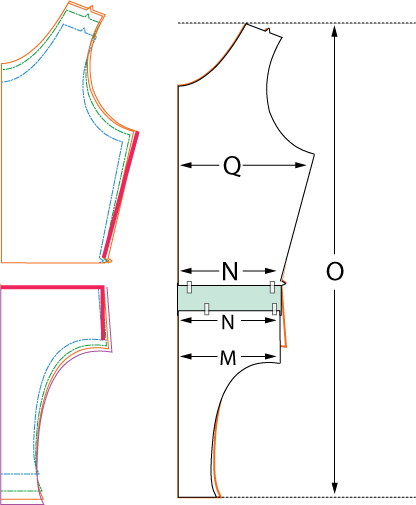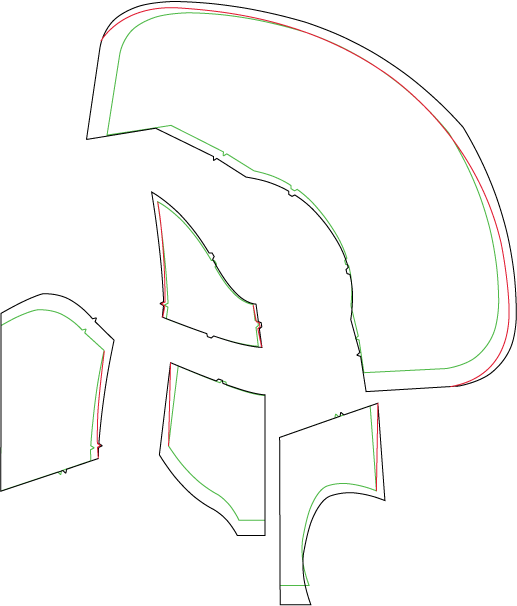How to Pick the Right Leotard / Dress Size
This blog post is a summary of tons of emails I answered over the years. If those moms and seamstresses emailed me for help, I'm sure there are thousands of people out there who will be happy to learn how to pick the right size on the back of the Jalie pattern :)
USE BODY MEASUREMENTS, NOT AGE
You should always, ALWAYS, use recent body measurements (that you take yourself - if possible) AND work with the measurement chart on the back of the pattern. You can find a link to pattern sizing on all pattern pages on our website, just below the pattern's description.
As you will notice, we use letters instead of numbers so that people don't automatically cut their size according to what they used with another company. If you follow a few simple rules, your leotard should fit just as well as the leotard on the pattern cover.
REMEMBER: You want to stay away from sleeve/armhole/crotch alterations as much as possible! Lengthening at the waist is the easiest way to go.
REMEMBER THESE THREE STEPS:
- Find the size that is the best match for B/W/H measurements
- Compare the actual torso measurement (body) to the torso measurement for the size you are using
-
Lengthen or shorten by half the difference
- WARNING: For big size differentials (especially tall, slender people), an alternate method - where you use the torso length and adjust in the width based on bust/waist/hips measurement - may work better.
- Front and back bodice pieces (around waist level)
- Sleeves (around elbow level) - don't alter if you are making a short or cap sleeve
EXAMPLES
Making your daughter's gymnastics leotard was so easy and so much fun that you volunteered to make outfits for the whole club... You measure the girls and unlike your daughter, their bust/waist/hips/torso measurements don't fall in the same Jalie size column.
Take a deep breath! It will be all right.
Here are examples based on real measurements and stories we received from customers over the years. If after reading this you are still unsure about which size you should use, please email us through our contact form and we will gladly give you some advice.
Rachel: LONG TORSO and/or SMALL FRAME
Rachel is 8 and her mom says her size 5 t-shirts would still fit but are all wayyy too short. She always comes to the gym with leotards that are loose-fitting, but that seem to pull in the length. This means her torso probably corresponds to a larger size than her B/W/H. Let's see:
1 - Find size for BUST/WAIST/HIPS
- It is easy to take it at the waist at fitting, so we will remove the waist measurement (size H) from our sizing puzzle. You can take in at the waist when tracing or at fitting.
- Since Rachel is still growing, you want to go with size J (only 1 size bigger at the hips, which is ok)
2 - Compare TORSO
- Size J is designed for 41 1/2" torso, but Rachel's torso is 45 inches.
- You are missing 3 1/2" (45 - 41 1/2) total
3 - Lengthen
- Divide that by two and you get 1 3/4". This is what you need to add to both the front and back pieces (around waist level)
- WARNING: For big size differentials (especially tall, slender people), an alternate method - where you use the torso length and adjust in the width based on bust/waist/hips measurement - may work better.
Louisa: SHORT TORSO and/or HUSKY/PLUS SIZE
Louisa is a short 8 year-old but her mom has to buy her teen clothing. The clothes fit nicely around the body, but are always too long. Louisa is used to wearing leotards that are always too long for her, but you want to make her one that will fit her like a second skin! Let's take a look at her measurements:
1 - Find size for BUST/WAIST/HIPS
- Louisa's measurements are a size P, but you will have to trace out to size Q at the waist to give her a little more room.
2 - Compare TORSO
WHAT DID I GET MYSELF INTO? THIS CHILD'S MEASUREMENTS ARE ALL OVER THE CHART!
Every person is unique and so are their measurements. Don't worry, this happens all the time. You are not alone!
If this scares you a little, pick a time when you are not too tired to play with numbers and do minor alterations on the pattern and keep on reading.
Donna: Bust is way off (bigger or smaller)
Donna is an artistic gymnast with very strong upper body and is more developed than her teammates. Her bust measurement is much bigger than her other measurements:
BUST/WAIST/HIPS
- Louisa's bust measurement is size Q. Because she is very muscular, she would probably need size Q for sleeves to (it's easier to take in than to let out anyway). This means for a yoke of the upper bodice (where the armhole is) you need size Q, but will have to trace down to size N towards the waist
- Her hips are much smaller so you trace a paper piece for size M at leg opening, going towards size N at the waist.
TORSO and SLEEVES
- The pieces you are using are both below and above her measured torso.
- Align the crotch line of your bottom piece with size O crotch line. Align the top edge with size O top edge and tape your two paper pieces together. You have a new, custom leotard pattern!
- If making a long sleeve, you will have to shorten it by 2" as per our little formula (55-51 divided by 2).
Michelle: Hips are way off (bigger or smaller)
All of Michelle's measurements are within 1 size of size L - yeah! But wait... the hips are 4 sizes down!!!?! You need to alter the pattern otherwise the leotard will be very, very baggy!
BUST/WAIST/TORSO
- Trace a size L (you can trace outwards at the waist to match size M if you are a perfectionnist) as is.
HIPS
- If you make the leotard as is, the hips will be way to big. This means that the leg opening will look higher than it should and nothing will stay in place (and will look baggy).
- I'm sure you would be tempted to simply take in at the sides. If you do that, you will lower the leg opening and it might cut across the top of the thigh, which is not what you want either.
- Here is how to remove the extra width at the hips while keeping the leg opening shape:
|
1) Cut your pattern pieces close to the waist notch, cut the bottom section as shown 2) Pivot the outer piece to match the size corresponding to the girls' hips measurement. 3) Redraw the leg opening.
|
Harvey: Altering patterns for men
The coach would like to have a custom jacket for the competition but Jalie does not have one... Guess what? You can use the magic formula to make a great 2795 jacket or zip-front hoodie ! The torso measurement is not in the 2795 measurement chart, but you can use your leotard pattern as a reference (our chart is the same for all patterns).
BUST/WAIST/HIPS
- Harvey's chest measurement is 40"
- Trace a size Y for all the pieces
- There will be extra room at the waist and hips, which is ok for a jacket.
TORSO AND SLEEVES
- Size Y is designed for 64 1/2" torso, but Harvey's torso is 69 1/2".
- You are missing 5" (69 1/2 - 64 1/2) total
- Divide that by two and you get 2 1/2". This is what you need to add to front and back pieces (around waist level) and sleeves (around elbow level).
SKATING DRESS SIZING HELP
The great thing about skating dresses is that they often have a waist seam, which allows you to use different size for bottom (brief and skirt) and bodice. It all works well when the top and bottom are only 1-2 sizes apart but can get a bit complicated when measurements are all over the chart.
Jessica: Thin girl wants a beautiful princess skating dress
Jessica is a thin 11-year-old skating who has a tiny waist and muscular buttocks and legs (typical skater shape). Her dresses are often too big because she has to go a few sizes up for the dresses to be long enough for her torso. With our huge range size, you will be able to make a princess dress that will fit her like a glove!
CHOOSING THE SIZE FOR TRACING
- Because the dress has a waist seam, you can trace size K for the bodice and sleeve.
- Because her waist is smaller, you might have to take it a little at the waist at fitting
- Size L will be perfect for the briefs and skirt.
- No need to lengthen the short sleeve. Make size K as is.
PATTERN ALTERATIONS
- Because you are using K and L, your pattern torso is for approximately 44" but you need 51" total
- 51"- 44" = 7", divided by two is 3 1/2" : 3 1/2" would be a lot for the bodice pieces only. We will spread it above and below waist level
- lengthen the bodice pieces by 2 1/4"
- lengthen the briefs pieces by 1 1/4"
- you can lengthen the skirt by 1 1/2", but since she is still growing, you could add up to 2" to both skirt pieces
Jenny: A fun sizing challenge
Jenny wants a strapless illusion skating dress, but usually her dresses area always too long in the bodice because she has to dresses made for older girls to fit her in the bust and waist. As I explained earlier, using the correct length pattern is very important whenever there is a seam above the bust line (strapless/sweetheart illusion).
CHOOSING THE SIZE FOR TRACING
- Her bust (31") and hips (33") are a size P, but her waist is 6 size bigger at V.
- The waist seam being lower than the natural waist, it means that you can go in between for the waist seam (it goes gradually from V at navel (U, T, S, R, Q) to P at full hips). Size S at the seam would be reasonable.
- With the recommended fabric having 70% stretch, it will stretch easily from 28 (size S) to 31 (size V).
- For the bodice, you will need P in the width but O in the length. Because Jenny is only 8 years old and because the extra stretching at the waist will make the dress a bit shorter, I would leave the length as is, one size extra will not be too long for her.
- For the panties, trace P, widening to S at the waist.
- For the skirt, you will need S waist with O length.
PATTERN ALTERATIONS
- Trace bodice pieces going from size P (in green) to size S (black) at waist seam
- Same thing for briefs
- For the skirt, apply size O (green) skirt length to size S (black) skirt waist and redraw the curve (red)
YOUR FABRIC MUST STRETCH BOTH WAYS
All of these calculations and tips are 100% useless if your fabric does not have the recommended stretch. I know, sometimes you find THE perfect fabric in THE perfect color at the perfect price, hoping it wouldn't really matter if the stretch is not exactly what is recommended on the back of the pattern.
IT DOES MATTER. A LOT.
Some people call it 2-way (width and length), others call it 4-way (up, down, left, right). Your fabric has to stretch around the body AND in the length (otherwise your garment will feel wayyy to short - will not be wearable).
Keep your one-way stretch fabrics for skirts or ruffles. Make sure all the fabrics you use for skating dress (from muslins/testers to final dresses) stretch both ways.
If you are buying online, take the time to order a swatch to see if the stretch and recovery are what you need. More and more stores give more details about stretch, but not all of them. Sometimes the information can be incorrect as well...
Better check twice, order once :)
Common fitting issues - CHEAT SHEET
Too big (width)
- You see the nude mesh floating away from the body
- Sleeves are loose
- Leg openings are not tight, the briefs do not stay in place (because there is too much fabric).
What happened?
- You picked a size based on age (a size 8 garment for an 8-year-old who is as thin as a 4-year-old)
- The child was not available for measurement or the mom sent you "estimates"...
- You picked a size based on the bigger torso measurement only
- You picked a size based on age or ready-to-wear size
Too long
- Everything is too low armhole, waist, neckline, bodice (in sweetheart leotards) - beware of wardrobe malfunctions when using sheer fabric for upper bodice!)
- Baggy briefs (ok at the hips, but baggy at the bottom)
- Lots of pleats at center back
What happened?
- You picked the size based on width measurements only
- The customers wants growing room
- Growing room is ok to make sure the dress/leotard lasts until the end of the season. Making a dress that will fit like a glove from 6 to 8 years old is impossible.
- You would not buy pants that are two sizes bigger and way too long for a child... why do it for a leotard/dress that you can make again in the fabric scraps once the first one is too small?
Too small
- Can't put it on / Can't breath
- Sleeves too tight
What happened?
- You picked a size based on a short torso measurement only
- You picked a size based on age or ready-to-wear size
- Your fabric did not have enough stretch in the width (different topic I will cover in another post)
Too short
- Neckline pulling down
- "Wedgie"
- Leg opening stretched upwards (think 90's swimsuit leg) - this can also be caused by a few sizes too big at the hips (leotard not staying in place)
What happened?
- You picked a size based on small bust/waist/hips measurement only
- You picked a size based on age or ready-to-wear size
- Your fabric did not have enough stretch in the length (different topic I will cover in another post)
Happy sewing!
← 2918 V-Neck T-Shirt // Video tutorial 3136 Skating Dress // Video Tutorial →


















